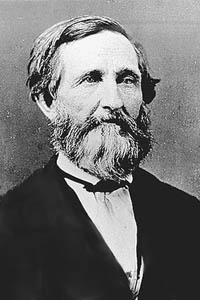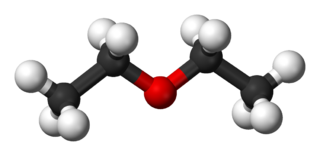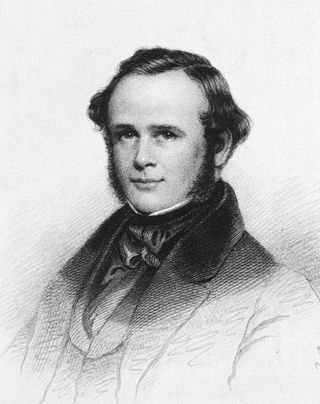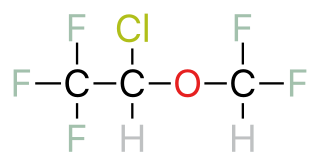
Anesthesia or anaesthesia is a state of controlled, temporary loss of sensation or awareness that is induced for medical or veterinary purposes. It may include some or all of analgesia, paralysis, amnesia, and unconsciousness. An individual under the effects of anesthetic drugs is referred to as being anesthetized.

Halothane, sold under the brand name Fluothane among others, is a general anaesthetic. It can be used to induce or maintain anaesthesia. One of its benefits is that it does not increase the production of saliva, which can be particularly useful in those who are difficult to intubate. It is given by inhalation.

Isoflurane, sold under the brand name Forane among others, is a general anesthetic. It can be used to start or maintain anesthesia; however, other medications are often used to start anesthesia, due to airway irritation with isoflurane. Isoflurane is given via inhalation.

Sevoflurane, sold under the brand name Sevorane, among others, is a sweet-smelling, nonflammable, highly fluorinated methyl isopropyl ether used as an inhalational anaesthetic for induction and maintenance of general anesthesia. After desflurane, it is the volatile anesthetic with the fastest onset. While its offset may be faster than agents other than desflurane in a few circumstances, its offset is more often similar to that of the much older agent isoflurane. While sevoflurane is only half as soluble as isoflurane in blood, the tissue blood partition coefficients of isoflurane and sevoflurane are quite similar. For example, in the muscle group: isoflurane 2.62 vs. sevoflurane 2.57. In the fat group: isoflurane 52 vs. sevoflurane 50. As a result, the longer the case, the more similar will be the emergence times for sevoflurane and isoflurane.

Crawford Williamson Long was an American surgeon and pharmacist best known for his first use of inhaled sulfuric ether as an anesthetic.

The Ether Dome is a surgical operating amphitheater in the Bulfinch Building at Massachusetts General Hospital in Boston, United States. It served as the hospital's operating room from its opening in 1821 until 1867. It was the site of the first public demonstration of the use of inhaled ether as a surgical anesthetic on October 16, 1846, otherwise known as Ether Day. Crawford Long, a surgeon in Georgia, had previously administered sulfuric ether in 1842, but this went unpublished until 1849. The Ether Dome event occurred when William Thomas Green Morton, a local dentist, used ether to anesthetize Edward Gilbert Abbott. John Collins Warren, the first dean of Harvard Medical School, then painlessly removed part of a tumor from Abbott's neck. After Warren had finished, and Abbott regained consciousness, Warren asked the patient how he felt. Reportedly, Abbott said, "Feels as if my neck's been scratched". Warren then turned to his medical audience and uttered "Gentlemen, this is no Humbug". This was presumably a reference to the unsuccessful demonstration of nitrous oxide anesthesia by Horace Wells in the same theater the previous year, which was ended by cries of "Humbug!" after the patient groaned with pain.

Desflurane (1,2,2,2-tetrafluoroethyl difluoromethyl ether) is a highly fluorinated methyl ethyl ether used for maintenance of general anesthesia. Like halothane, enflurane, and isoflurane, it is a racemic mixture of (R) and (S) optical isomers (enantiomers). Together with sevoflurane, it is gradually replacing isoflurane for human use, except in economically undeveloped areas, where its high cost precludes its use. It has the most rapid onset and offset of the volatile anesthetic drugs used for general anesthesia due to its low solubility in blood.

William Thomas Green Morton was an American dentist and physician who first publicly demonstrated the use of inhaled ether as a surgical anesthetic in 1846. The promotion of his questionable claim to have been the discoverer of anesthesia became an obsession for the rest of his life.

Diethyl ether, or simply ether, is an organic compound with the chemical formula (CH3CH2)2O, sometimes abbreviated as Et2O. It is a colourless, highly volatile, sweet-smelling, extremely flammable liquid. It belongs to the ether class of organic compounds. It is a common solvent. It was formerly used as a general anesthetic.

Horace Wells was an American dentist who pioneered the use of anesthesia in medicine, specifically the use of nitrous oxide.

Enflurane is a halogenated ether. Developed by Ross Terrell in 1963, it was first used clinically in 1966. It was increasingly used for inhalational anesthesia during the 1970s and 1980s but is no longer in common use.

An inhalational anesthetic is a chemical compound possessing general anesthetic properties that is delivered via inhalation. They are administered through a face mask, laryngeal mask airway or tracheal tube connected to an anesthetic vaporiser and an anesthetic delivery system. Agents of significant contemporary clinical interest include volatile anesthetic agents such as isoflurane, sevoflurane and desflurane, as well as certain anesthetic gases such as nitrous oxide and xenon.

A halogenated ether is a subcategory of a larger group of chemicals known as ethers. An ether is an organic chemical that contains an ether group—an oxygen atom connected to two (substituted) alkyl groups. A good example of an ether is the solvent diethyl ether. What differentiates a halogenated ether from other types of ethers is the substitution (halogenation) of one or more hydrogen atoms with a halogen atom. Halogen atoms include fluorine, chlorine, bromine, and iodine.

Methoxyflurane, sold under the brand name Penthrox among others, is an inhaled medication primarily used to reduce pain following trauma. It may also be used for short episodes of pain as a result of medical procedures. Onset of pain relief is rapid and of a short duration. Use is only recommended with direct medical supervision.
Guedel's classification is a means of assessing the depth of general anesthesia introduced by Arthur Ernest Guedel (1883–1956) in 1920.

Flurothyl (Indoklon) is a volatile liquid drug from the halogenated ether family, related to inhaled anaesthetic agents such as diethyl ether, but having the opposite effects, acting as a stimulant and convulsant. A clear and stable liquid, it has a mild ethereal odor whose vapors are non-flammable. It is excreted from the body by the lungs in an unchanged state.

Throughout recorded history, attempts at producing a state of general anesthesia can be traced back to the writings of ancient Sumerians, Babylonians, Assyrians, Egyptians, Indians, and Chinese. Despite significant advances in anatomy and surgical technique during the Renaissance, surgery remained a last-resort treatment largely due to the pain associated with it. However, scientific discoveries in the late 18th and early 19th centuries paved the way for the development of modern anesthetic techniques.
Blood–gas partition coefficient, also known as Ostwald coefficient for blood–gas, is a term used in pharmacology to describe the solubility of inhaled general anesthetics in blood. According to Henry's law, the ratio of the concentration in blood to the concentration in gas that is in contact with that blood, when the partial pressure in both compartments is equal, is nearly constant at sufficiently low concentrations. The partition coefficient is defined as this ratio and, therefore, has no units. The concentration of the anesthetic in blood includes the portion that is undissolved in plasma and the portion that is dissolved. The more soluble the inhaled anesthetic is in blood compared to in air, the more it binds to plasma proteins in the blood and the higher the blood–gas partition coefficient.
Obstetric anesthesia or obstetric anesthesiology, also known as ob-gyn anesthesia or ob-gyn anesthesiology, is a sub-specialty of anesthesiology that provides peripartum pain relief (analgesia) for labor and anesthesia for cesarean deliveries ('C-sections').

Dr. Horace Wells, also known as the Horace Wells Monument, is a monumental statue in Hartford, Connecticut, United States. The statue, located in the city's Bushnell Park, was designed by sculptor Truman Howe Bartlett and dedicated in 1875 in honor of Horace Wells, a dentist who was a pioneer in the use of anesthesia.
























